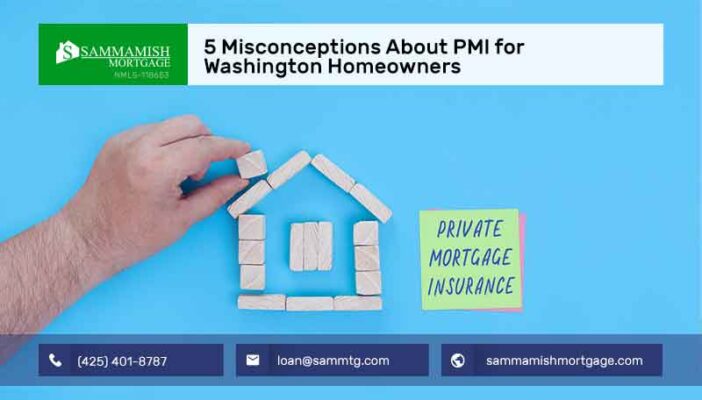No Obligation and transparency 24/7. Instantly compare live rates and costs from our network of lenders across the country. Real-time accurate rates and closing costs for a variety of loan programs custom to your specific situation.

Private mortgage insurance can be a confusing subject for first-time home buyers. And a lack of knowledge opens the door to misconceptions and misunderstanding. Today, we will address some of the most common “myths” and misconceptions about private mortgage insurance in the state of Washington.
Private mortgage insurance (PMI) is a type of insurance lenders sometimes require when a borrower makes a down payment of less than 20% on a conventional mortgage. More specifically, it’s usually required when the borrower’s loan-to-value (LTV) ratio exceeds 80%.
PMI protects the lender in case the borrower defaults on their loan. In Washington, PMI premiums are added onto the monthly mortgage payment and typically range from 0.5% to 1.5% of the loan amount. Homeowners can request to have their PMI policies canceled once they reach 20% equity in their home.
With that introduction out of the way, let’s debunk some of the biggest misconceptions Washington home buyers have regarding private mortgage insurance.
As mentioned above, a loan-to-value (LTV) ratio above 80% typically triggers the PMI requirement in Washington. But that doesn’t necessarily mean you have to put down 20% to avoid paying private mortgage insurance. There are ways to avoid PMI even when making a down payment below the 20% threshold.
For example, some home buyers in Washington combine two mortgage loans to finance their purchase. They might take out a first mortgage that amounts to 80% of the purchase price, along with a second loan to cover an additional 10%. The buyer then pays the remaining 10% in the form of a down payment.
In this scenario, neither one of the mortgage loans would account for more than 80% of the home’s value. So private mortgage insurance would not be required in this case. This is often referred to as the “piggyback” or “80-10-10” loan strategy.
On the other hand, if a home buyer in the state of Washington uses a single mortgage loan that accounts for more than 80% of the value, PMI would probably be required. When it comes to whether or not you have to pay for a mortgage insurance policy, it’s the loan-to-value ratio that matters most.
Private mortgage insurance increases the size of your monthly loan payments. It’s one of the four main factors that make up a typical monthly mortgage payment (along with the principal, interest, and taxes). That’s why home buyers in Washington usually try to avoid PMI at all costs.
But PMI also provides some pretty substantial benefits from a borrower’s perspective. For one thing, it creates a shorter and easier path to homeownership.
Without mortgage insurance, a 20% down payment would likely become the minimum requirement for nearly all home buyers who use loans. And that would put homeownership out of reach for a lot of people.
The median home value for the state of Washington is currently $577,000. So a 20% down payment in that range would come to around $115,000. In the Seattle metro area, where home prices exceed the statewide average, a typical down payment could cost more than $140,000.
An upfront investment of that level would be cost-prohibitive for many home buyers. And therein lies the value of private mortgage insurance. It allows borrowers to make a much smaller down payment, as low as 3% in some cases. This helps clear one of the biggest hurdles to homeownership, which is the upfront out-of-pocket expense.
In short, PMI allows home buyers in Washington to purchase a home sooner and with less money down. So even though the policy protects the lender, it offers major benefits to the borrower as well.
Mortgage insurance and home insurance share a word in common, but the similarities basically end there. The truth is they are two very different things. One is designed to protect the lender (as explained above), while the other shields the homeowner from financial losses caused by damage to the home or its contents.
In Washington, homeowners’ insurance policies are typically required when a home buyer uses a mortgage loan to finance their purchase. Mortgage insurance, on the other hand, is only required when the loan-to-value ratio exceeds the 80% threshold mentioned earlier.
Not every borrower in Washington pays the same mortgage insurance premium. In fact, PMI premiums can vary due to a number of factors. They use a risk-based pricing model similar to the ones used for many different financial products.
Down payments and credit scores play a role here. Generally speaking, a home buyer with a higher credit score might pay less for PMI. Similarly, a borrower who makes a bigger down payment might qualify for a lower private mortgage insurance premium.
There are other factors that go into that can affect the pricing of PMI, but those are two of the big ones.
Washington homeowners with PMI policies can usually cancel them once the loan-to-value ratio falls to 80% or below. This happens naturally over time, as the homeowner makes regular monthly payments and reduced the loan balance.
This is a good place to clarify the difference between private and government mortgage insurance since the rules are different regarding cancellation.
Conventional loans are those that do not receive any kind of government insurance or guarantee. Private mortgage insurance applies to conventional loans, in particular.
FHA loans are offered by lenders within the private sector, but they’re insured by the federal government. This distinguishes them from conventional mortgage financing mentioned above.
Most borrowers in Washington who use the FHA loan program have to pay their annual mortgage insurance premium for as long as they keep the loan. But with conventional financing, homeowners can cancel the PMI policy when their home equity rises to 20% or above.
Have questions? If you’re planning to buy a home in the state of Washington, and you have questions about mortgage insurance, please contact our staff. We can review your current financial situation and long-term goals to determine the best path toward homeownership.


Whether you’re buying a home or ready to refinance, our professionals can help.
{hours_open} - {hours_closed} Pacific
No Obligation and transparency 24/7. Instantly compare live rates and costs from our network of lenders across the country. Real-time accurate rates and closing costs for a variety of loan programs custom to your specific situation.